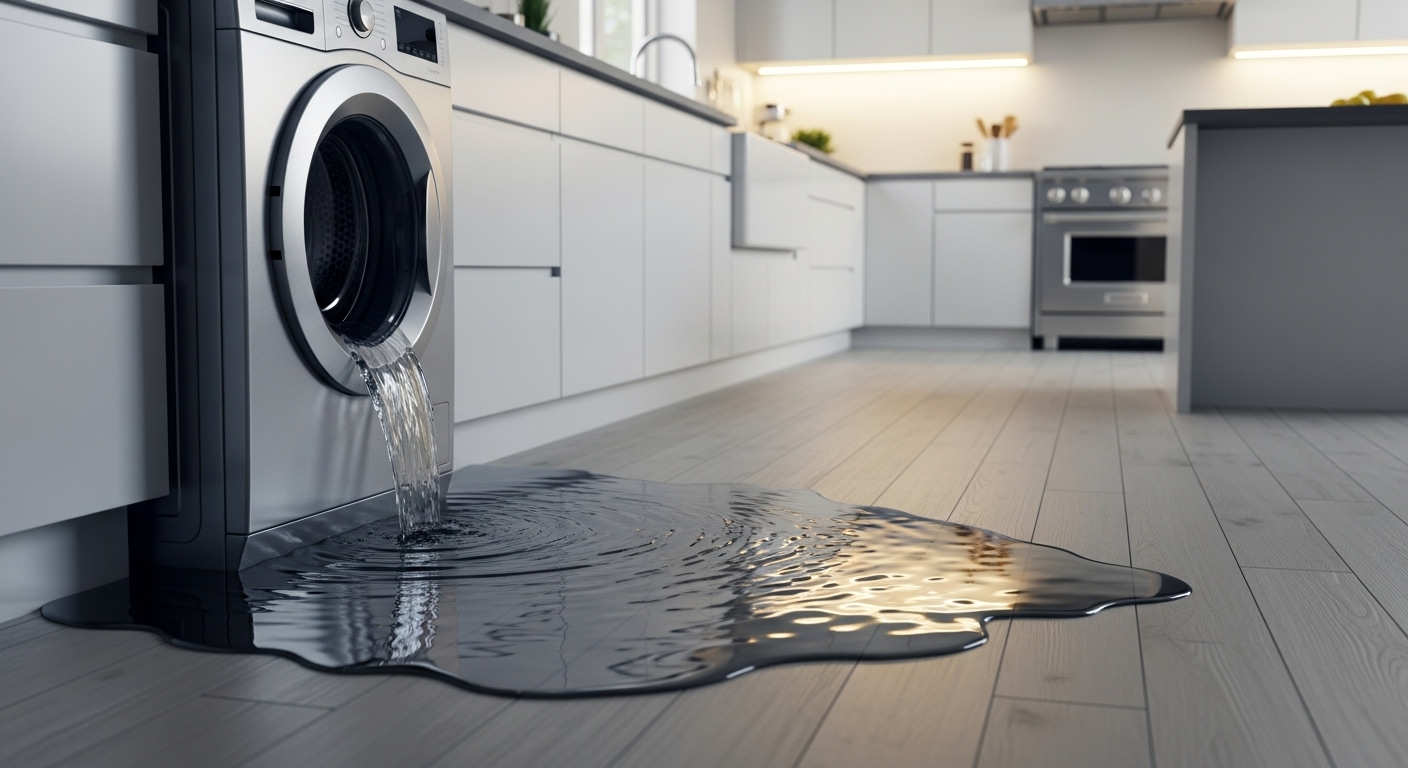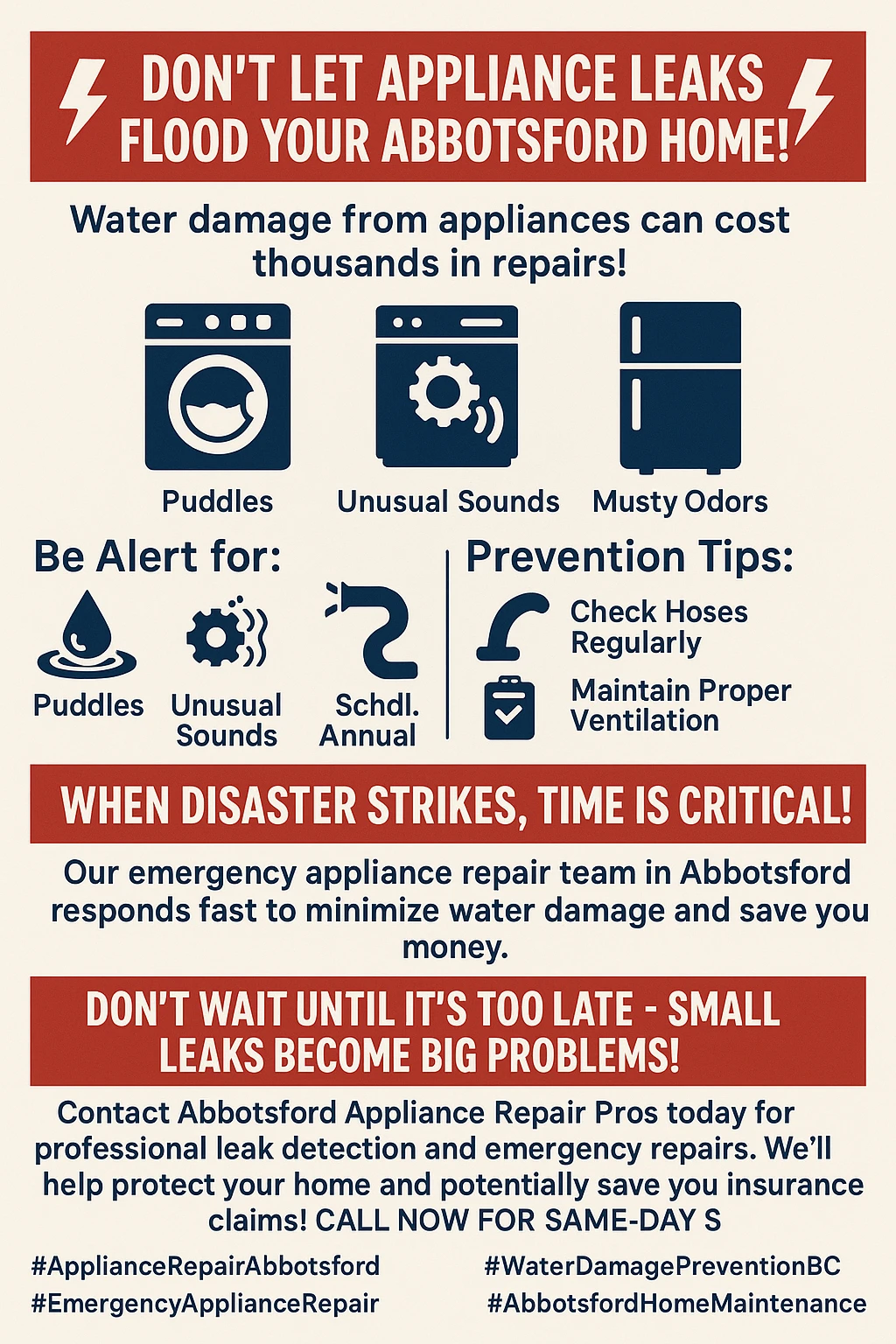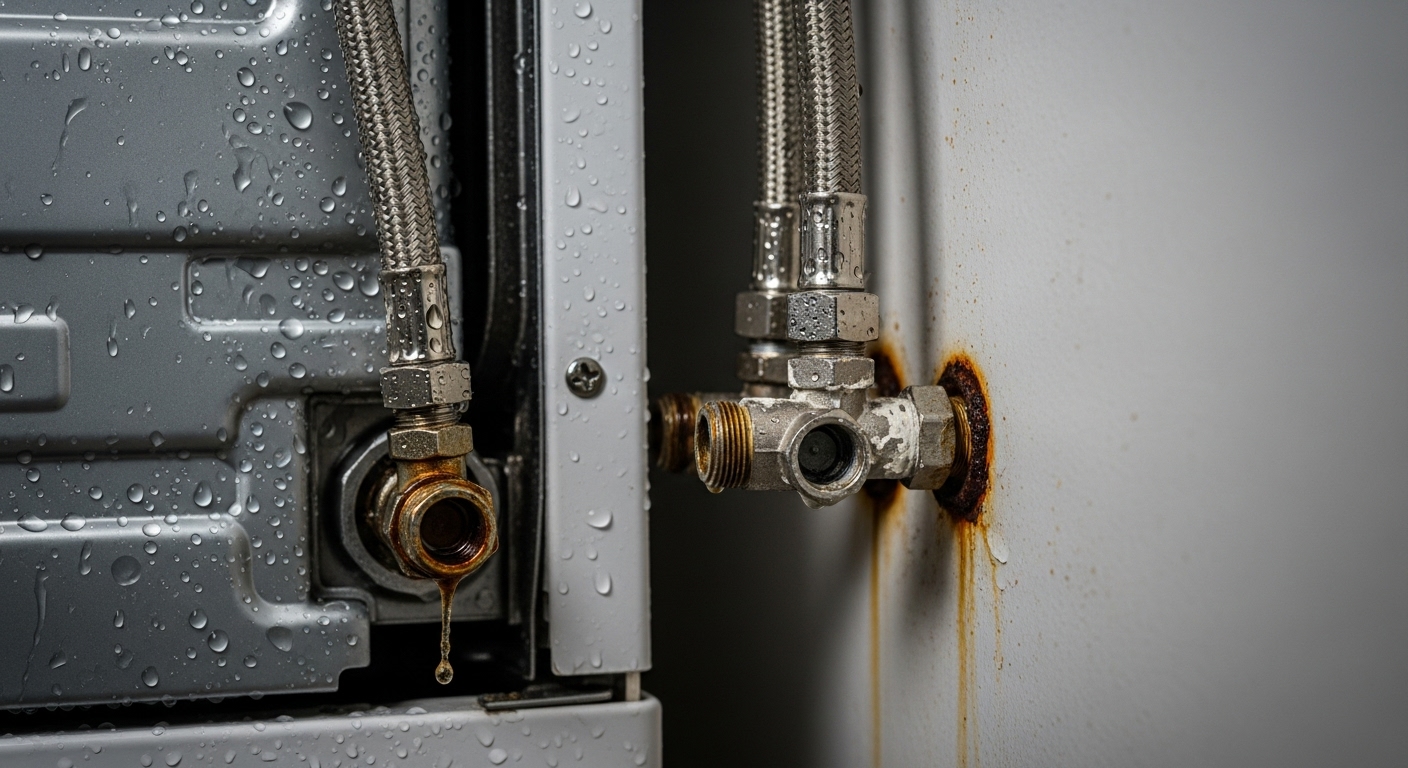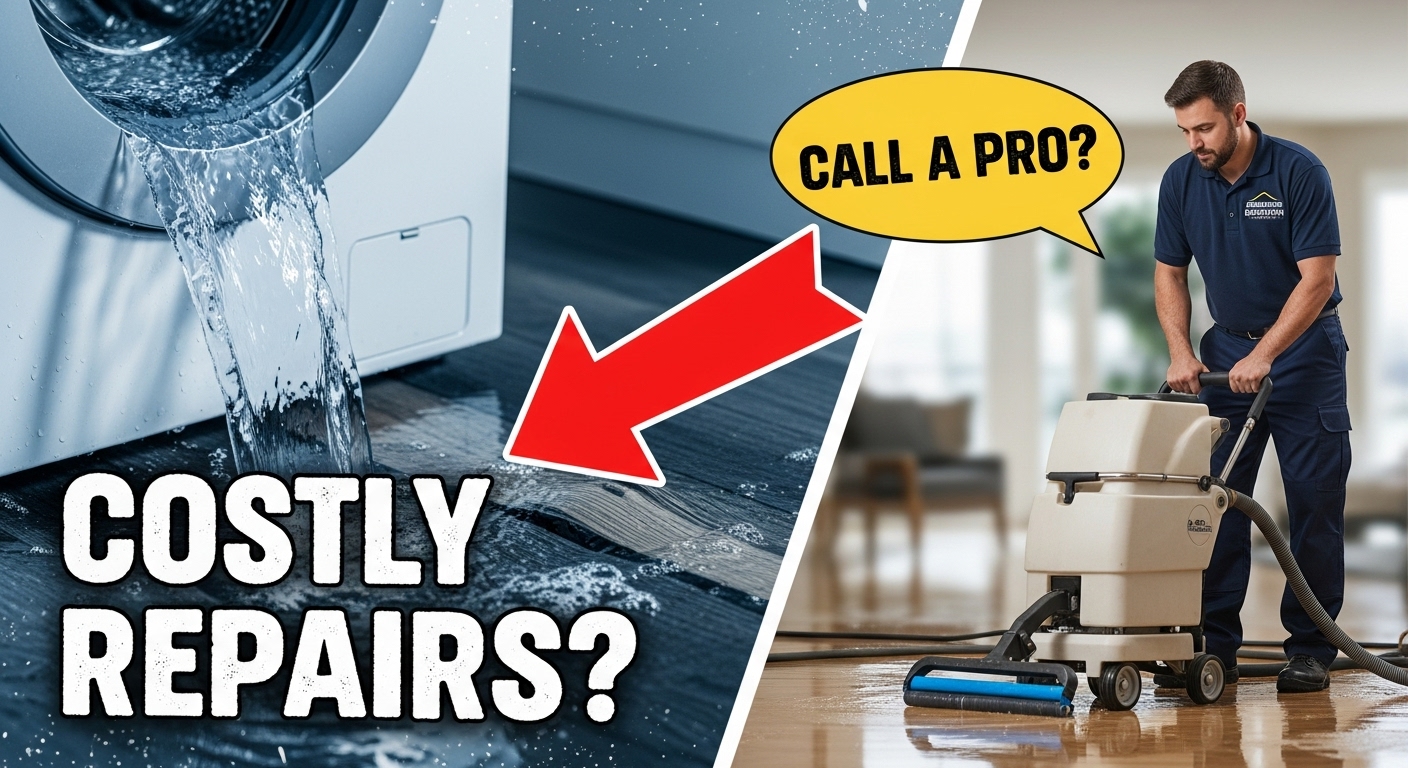Experiencing unexpected water pooling around your washing machine or dishwasher? Understanding the risks and prevention strategies for appliance leak water damage in Abbotsford can save you thousands in costly repairs while protecting your home from serious structural issues. Water damage from household appliances represents one of the most significant and preventable threats to Abbotsford homeowners, with appliance-related incidents accounting for a substantial portion of residential water damage claims across British Columbia. The region’s unique climate conditions, characterized by frequent rainfall and elevated humidity levels, create an environment where even minor appliance leaks can rapidly escalate into costly restoration projects requiring professional intervention. Understanding the common sources of appliance-related water damage, implementing effective prevention strategies, and knowing when to engage professional repair services can save homeowners thousands of dollars while protecting their most valuable investment.  Professional restoration services across the Abbotsford area have documented increasing frequency of appliance-related water damage incidents, particularly during seasonal transitions when temperature fluctuations stress appliance connections and seals. The combination of Vancouver’s coastal moisture and indoor heating creates conditions that accelerate wear on appliance components, making proactive maintenance and early detection systems essential for property protection. Homeowners who implement comprehensive prevention strategies and maintain relationships with qualified professionals can significantly reduce both the likelihood and impact of water damage events.
Professional restoration services across the Abbotsford area have documented increasing frequency of appliance-related water damage incidents, particularly during seasonal transitions when temperature fluctuations stress appliance connections and seals. The combination of Vancouver’s coastal moisture and indoor heating creates conditions that accelerate wear on appliance components, making proactive maintenance and early detection systems essential for property protection. Homeowners who implement comprehensive prevention strategies and maintain relationships with qualified professionals can significantly reduce both the likelihood and impact of water damage events.
Key Takeaways
- Water damage accounts for approximately 50% of home insurance claims costs in Canada, with appliance failures being a leading cause of residential water incidents
- Regular inspection and maintenance of appliance hoses, seals, and connections can prevent up to 90% of common appliance-related water damage
- Smart leak detection systems and automatic shutoff valves can reduce water damage costs by stopping leaks within minutes of detection
- Professional intervention is essential for electrical appliances exposed to water, structural damage assessment, and insurance claim documentation
- Abbotsford’s coastal climate requires enhanced vigilance for appliance maintenance due to increased humidity and condensation risks

Understanding Appliance Leak Risks in Abbotsford’s Climate
The Pacific Northwest climate presents unique challenges that directly impact appliance performance and longevity throughout the Lower Mainland region. Vancouver’s coastal environment exposes homeowners to elevated humidity levels and frequent temperature fluctuations that can accelerate component deterioration in household appliances. Understanding these regional factors helps homeowners develop targeted prevention strategies that address local environmental stressors rather than relying solely on manufacturer recommendations designed for average conditions.
Frequent rainfall and elevated atmospheric moisture levels in Abbotsford create conditions where appliance cabinets and connection areas experience higher humidity than typical residential environments. This persistent moisture exposure can infiltrate gasket materials, corrode metal connections, and create condensation buildup that may not be immediately visible to homeowners. Professional appliance services in the Vancouver area report increased service calls during seasonal transitions when temperature differentials cause expansion and contraction in appliance components.
Temperature variations between seasons cause expansion and contraction cycles in appliance connections, potentially loosening fittings that appeared secure during installation. Winter heating cycles generate condensation around appliances, particularly in laundry rooms and kitchens where warm, moist air contacts cooler surfaces. The combination of external moisture intrusion and normal appliance operation creates an environment where seals and gaskets experience accelerated aging compared to drier climates.

Coastal areas experience higher insurance premiums due to increased water damage risks, making prevention strategies particularly cost-effective for Abbotsford homeowners. Insurance companies recognize the correlation between coastal climates and appliance-related claims, often requiring enhanced documentation of maintenance efforts for coverage approval. Regional repair services have adapted their maintenance recommendations to address local climate factors, emphasizing more frequent inspection schedules and moisture-resistant component upgrades.
Elevated humidity levels throughout the Fraser Valley can cause accelerated deterioration of rubber seals, increased corrosion of metal components, and premature failure of electronic control systems in modern appliances. Professional technicians recommend installing dehumidification systems in appliance areas and ensuring adequate ventilation to combat moisture-related degradation. The persistent moisture exposure common to Lower Mainland homes requires homeowners to implement more aggressive inspection schedules and consider climate-specific upgrades during appliance installation.
Common Appliance Leak Sources and Warning Signs
Understanding the most frequent sources of appliance leaks enables homeowners to focus their prevention efforts on high-risk areas while developing recognition skills for early warning signs. Professional restoration services consistently identify certain appliance types and failure patterns as primary contributors to residential water damage, providing valuable insights for targeted maintenance strategies. Recognizing these patterns helps homeowners allocate their time and resources effectively while building expertise in identifying potential problems before they become emergencies.
Washing machines represent the leading source of appliance-related water damage in residential properties, with supply hose failures accounting for the majority of significant incidents. Rubber hoses typically develop microscopic cracks and stress points after approximately five years of consistent use, with many failures occurring suddenly without obvious warning signs. The average cost of washing machine water damage exceeds $5,000 after professional mitigation and repairs, making early detection and prevention crucial for financial protection.

Supply line connections behind washing machines experience constant pressure fluctuations during fill cycles, creating stress points where failures commonly originate. Drain hoses can become clogged with lint and debris, causing backups that overflow onto floors and into wall cavities. Internal pump seals and door gaskets in front-loading machines develop leaks that may not be immediately visible but can cause extensive damage to flooring and cabinetry over time. Professional analysis of washing machine failures shows that regular hose replacement prevents the majority of catastrophic incidents.
Dishwasher leaks frequently originate from damaged drain hoses, faulty door seals, and improperly connected water supply lines that may not be discovered until significant water has accumulated beneath cabinets. These leaks often occur during wash cycles when doors remain closed, allowing water to spread undetected across kitchen floors and into adjacent rooms. Modern dishwashers include leak detection sensors that can automatically cancel wash cycles and display error codes when moisture is detected, but older units lack these protective features.
Door gasket deterioration in dishwashers creates small leaks that appear minor but can cause substantial damage to kitchen cabinetry and flooring materials over extended periods. Spray arm clogs and filter blockages can cause water to backup and overflow through door seals during normal operation. Connection points to garbage disposals and sink drains represent additional failure points where loose fittings can cause immediate flooding during dishwasher operation.
Refrigerators equipped with ice makers and water dispensers contain complex internal water line systems that can develop leaks in areas that remain hidden behind the unit or inside wall cavities. Frozen or blocked defrost drains cause water to accumulate inside refrigerator compartments and eventually overflow onto kitchen floors. Door gasket failures allow warm, humid air to enter refrigerator compartments, causing excessive condensation that can overwhelm internal drainage systems and create persistent moisture problems around the appliance.
Prevention Strategies and Maintenance Protocols
Implementing systematic prevention strategies provides the most cost-effective protection against appliance-related water damage while extending appliance lifespan and maintaining warranty coverage. Professional maintenance protocols developed by restoration specialists focus on identifying and addressing potential failure points before they result in water damage incidents. These strategies recognize that prevention costs significantly less than remediation while providing peace of mind for homeowners who may be away from their properties for extended periods.
Monthly visual inspections of appliance connections should focus on identifying signs of corrosion, mineral deposits, or moisture accumulation around water supply lines and drainage connections. Homeowners should examine hose conditions for cracks, bulges, or discoloration that indicate internal deterioration, with particular attention to areas where hoses bend or connect to appliances and wall fittings. Professional maintenance services recommend replacing rubber supply hoses every three to five years regardless of visible condition, as internal deterioration often precedes external signs of wear.
Quarterly detailed maintenance includes testing appliance drainage systems, cleaning lint filters and drain pumps, and verifying that shutoff valves operate smoothly and completely close water supplies when needed. Door gaskets and seals should be cleaned and inspected for cracks or hardening that can compromise their sealing effectiveness. Water pressure testing of supply lines helps identify weak points that may fail under normal operating pressures, allowing for proactive replacement before emergency situations occur.
Professional maintenance services can identify internal wear patterns and potential failure points that may not be visible during
